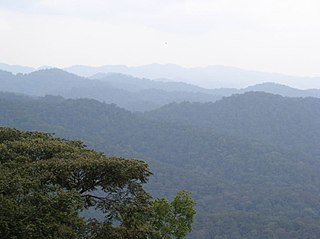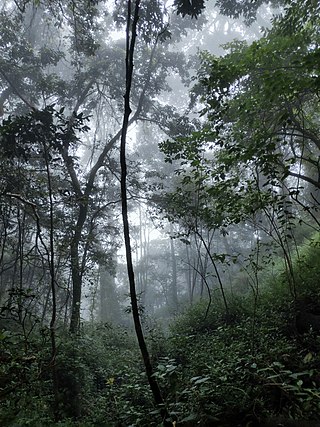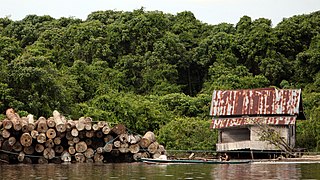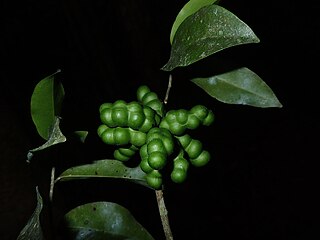
Logging is the process of cutting, processing, and moving trees to a location for transport. It may include skidding, on-site processing, and loading of trees or logs onto trucks or skeleton cars. In forestry, the term logging is sometimes used narrowly to describe the logistics of moving wood from the stump to somewhere outside the forest, usually a sawmill or a lumber yard. In common usage, however, the term may cover a range of forestry or silviculture activities.

Kibale National Park is a national park in western Uganda, protecting moist evergreen rainforest. It is 766 square kilometres (296 sq mi) in size and ranges between 1,100 metres (3,600 ft) and 1,600 metres (5,200 ft) in elevation. Despite encompassing primarily moist evergreen forest, it contains a diverse array of landscapes. Kibale is one of the last remaining expanses to contain both lowland and montane forests. In eastern Africa, it sustains the last significant expanse of pre-montane forest.

Neoboutonia is a plant genus of the family Euphorbiaceae first described as a genus in 1864. It is the only genus in subtribe Neoboutoniinae, and native to tropical Africa. It is dioecious.
- Neoboutonia macrocalyx Pax - Burundi, Cameroon, Rwanda, Zaire, Kenya, Tanzania, Uganda, Malawi, Zambia, Zimbabwe
- Neoboutonia manniiBenth. & Hook.f. - tropical Africa from Liberia to Mozambique
- Neoboutonia melleri(Müll.Arg.) Prain - tropical Africa from Nigeria to Mozambique

The mantled guereza, also known simply as the guereza, the eastern black-and-white colobus, or the Abyssinian black-and-white colobus, is a black-and-white colobus, a type of Old World monkey. It is native to much of west central and east Africa, including Cameroon, Equatorial Guinea, Nigeria, Ethiopia, Kenya, Tanzania, Uganda and Chad. The species consists of several subspecies that differ in appearance. It has a distinctive appearance, which is alluded to in its name; the long white fringes of hair that run along each side of its black trunk are known as a mantle. Its face is framed with white hair and it has a large white tail tuft.

Richard Walter Wrangham is an English]] anthropologist and primatologist; he is Professor of Biological Anthropology at Harvard University. His research and writing have involved ape behavior, human evolution, violence, and cooking.

The Albertine Rift montane forests is a tropical moist broadleaf forest ecoregion in east-central Africa. The ecoregion covers the mountains of the northern Albertine Rift, and is home to distinct Afromontane forests with high biodiversity.

Forest management is a branch of forestry concerned with overall administrative, legal, economic, and social aspects, as well as scientific and technical aspects, such as silviculture, forest protection, and forest regulation. This includes management for timber, aesthetics, recreation, urban values, water, wildlife, inland and nearshore fisheries, wood products, plant genetic resources, and other forest resource values. Management objectives can be for conservation, utilisation, or a mixture of the two. Techniques include timber extraction, planting and replanting of different species, building and maintenance of roads and pathways through forests, and preventing fire.

The wildlife of Uganda is composed of its flora and fauna. Uganda has a wide variety of different habitats, including mountains, hills, tropical rainforest, woodland, freshwater lakes, swamps and savanna with scattered clumps of trees. The country has a biodiverse flora and fauna reflecting this range of habitats and is known for its primates, including gorillas and chimpanzees. There are ten national parks and thirteen wildlife reserves; some 345 species of mammal and 1020 species of bird have been recorded in the country.

Khaya senegalensis is a species of tree in the Meliaceae family that is native to Africa. Common names include African mahogany, dry zone mahogany, Gambia mahogany, khaya wood, Senegal mahogany, cailcedrat, acajou, djalla, and bois rouge.

Afromorus mesozygia, known as black mulberry or African mulberry, is the only species in the genus Afromorus. The plant is a small- to medium-sized forest tree of Tropical Africa. Its leaves and fruit provide food for the mantled guereza, a colobus monkey native to much of Tropical Africa, and for the common chimpanzee of West and Central Africa. It is also a commercial hardwood.

Overlogging is a form of overexploitation caused by legal or illegal logging activities that lead to unsustainable or irrecoverable deforestation and permanent habitat destruction for forest wildlife.

The Ugandan red colobus or ashy red colobus is an endangered species of red colobus monkey, recognised as a distinct species since 2001. There is disagreement however over taxonomy with many considering the Ugandan red colobus to be a subspecies. The Ugandan red colobus is an Old World monkey which is found in five different locations across Uganda and Tanzania.
Mitragyna rubrostipulata is a tree indigenous to East Africa. It is native from Ethiopia through east-central tropical Africa to Mozambique. It grows in wet forests up to 2,000 m above sea level and is abundant in swamp forests along Lake Victoria.
Colin A. Chapman is a professor at the Vancouver Island University in British Columbia, Canada. In addition, he is a Fellow of the Royal Society of Canada, an Honorary Lecturer at Makerere University in Uganda, a Member of the Committee of Research and Exploration at National Geographic, and an Associate Scientists of the Wildlife Conservation Society in New York. Prior to taking on his position at McGill University, he was at the University of Florida in the Department of Zoology from 1993 to 2004. He is internationally recognized for his 30+ years of research into primate ecology, population regulation, nutrition, and disease dynamics and for his contribution to conservation globally.
Plasmodium billbrayi is a parasite of the genus Plasmodium subgenus Laverania.
Plasmodium billcollinsi is a species of the genus Plasmodium subgenus Laverania.
Professor Paul Waako, is a Ugandan pharmacologist, academic and academic administrator, who serves as the Vice Chancellor of Busitema University, a public university in the Eastern Region of Uganda, since 1 May 2019.
Entandrophragma angolense, called the tiama, is a tree species with alternate, pinnately compound leaves that are clustered at the ends of branches. It is within the family Meliaceae and has a wide distribution area, occurring in moist semi-deciduous and evergreen forest regions of Tropical Africa from Sierra Leone to Uganda.

Uvariopsis congensis is a species of plant in the Annonaceae family. It is native to Angola, Cameroon, the Central African Republic, the Democratic Republic of the Congo, Gabon, Ivory Coast, Kenya, Sudan, Uganda, Zambia. Walter Robyns and Jean Ghesquière, the botanists who first formally described the species, named it after the Belgian Congo, now called the Democratic Republic of the Congo, where the specimen they examined was collected in the town of Kisantu near the Inkisi River.

Vepris nobilis is a species of flowering plant in the family Rutaceae, native to the Arabian Peninsula and eastern Africa. A tree, chimpanzees use its leaves to repel the mosquito Anopheles gambiae.













